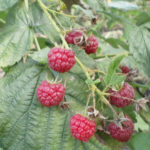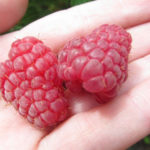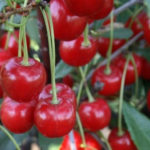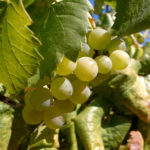Cherry variety Malinovka
Cherries come in different flavors and colors, but they still remain a favorite tree for many gardeners. It is beautiful in spring, during flowering, decorates the garden during fruiting and pleases with the taste of juicy berries. Varieties that bear fruit in the middle and late periods help to extend the period of consumption of your favorite fruits. These include a culture with such a summer name - Malinovka. The novelty appeared in 1977, it was announced by the All-Russian Institute of Selection and Technology of Horticulture and Nursery. The authors are H.K. Enikeev and S.N. Saratov. The variety has been on state variety testing since 1978. Date of entry into the State Register - 1989th year. Regions of admission - Central, Middle Volga, Ural.
Description
The tree is not very tall - 3 - 3.5 meters in height. It is decorated with a spherical, dense, slightly raised crown. Leaves are of normal size, with a crenate edge, elliptical in shape with a sharply pointed tip and a rounded base, green in color. The surface of the plate is ribbed, glossy. The underside of the sheet is lighter. The petiole is not very long and not thick. Fruiting occurs on last year's increments. Blooms in June.
The drupe cannot be called large, its weight is 3.5 - 4 grams. The shape is round, with a wide, shallow funnel and a rounded apex. The skin is thin, dense, at the time of ripeness it turns into a dark red color. The pulp is dense, tender, juicy, red. The juice is dark red. According to these indicators, cherries can be attributed to the popular variety - morel. The taste of Robin berries is sweet and sour. The peduncle is thin, short. Semi-dry separation. The stone is large, oval. It separates from the pulp easily, which greatly facilitates processing.

Variety characteristics
- The variety cannot be called fast-growing;
- the ripening period of the fruits is medium late or late, depending on the region. Most of the cleaning is done at the end of July;
- the yield exceeds the average and reaches 14 t / ha;
- in general, robinovka's disease resistance is not bad. There is an average resistance to coccomycosis, weaker to moniliosis;
- winter hardiness of cherries for growing regions is high - withstands -25 ° C. Crohn and flower buds show above average results. But the danger can be carried by recurrent spring frosts;
- the commercial quality of the fruit is high;
- the way of eating berries is universal.
Pollinators
The culture is self-fertile, which means that without a pollinator it is not able to show its potential. Therefore, you need to pick up neighbors blooming at the same time as the described variety. The best way to cope with the task Lyubskaya, Youth, Vladimirskaya or Shubinka. By the way, if the area of the garden does not allow planting a whole tree, then a pollinator branch can be grafted into the crown of the Robin.
Planting and growing
The variety prefers light sandy loam soils with neutral acidity. Cherry reacts extremely negatively to waterlogging of the root system, so the place should be selected dry, with a level of subsoil water no closer than 1.20 - 1.50 meters to the surface. Lighting also matters. In a shaded area, the berries will be small and sour. Competent pruning will allow you to regulate the yield, increase the sugar content and the size of the drupes, and keep the development of diseases under control.
The robin is good for a private garden and for industrial breeding. This is facilitated by good yields, marketability of fruits and their universal use. Late ripening is also a plus.
The variety has few disadvantages and is easy to deal with. Self-fertility of cherries requires the presence of a pollinator nearby.Disease resistance will increase preventive treatments, which should not be neglected.








